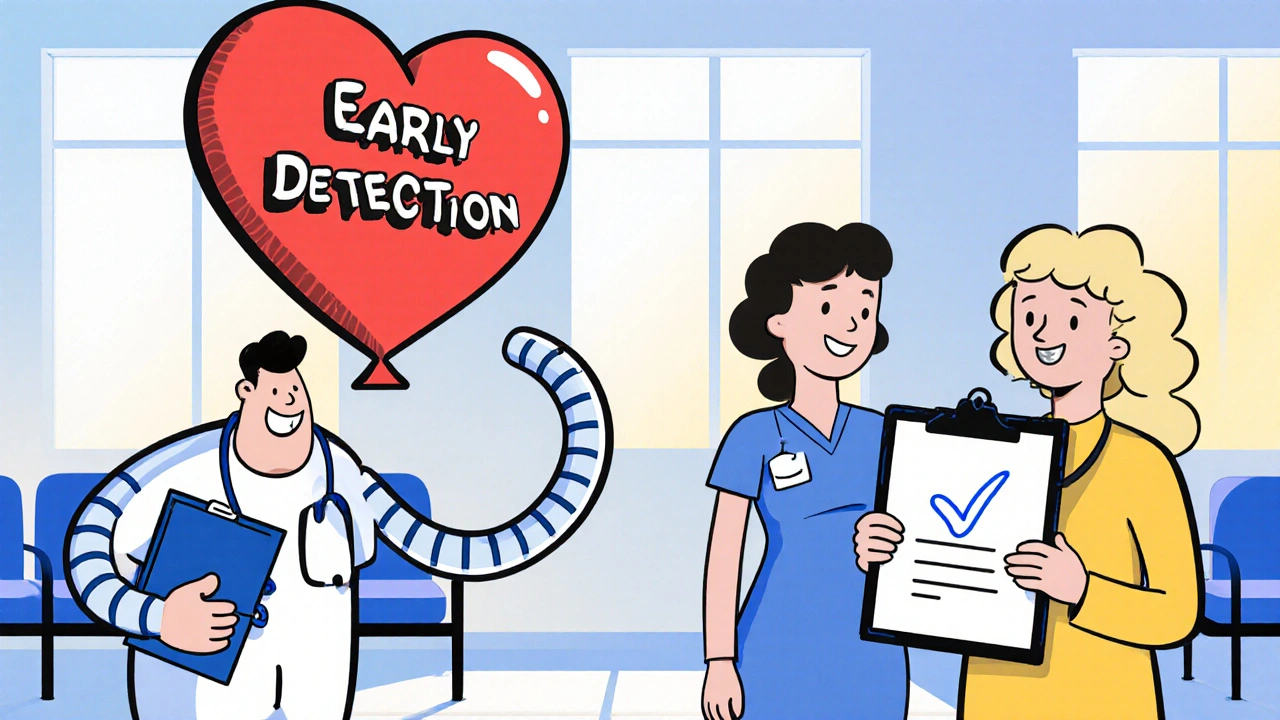Heart Failure Risk Assessment Tool
This tool estimates your risk of developing chronic heart failure based on key risk factors mentioned in medical guidelines. Early identification allows for timely intervention and better outcomes.
When Chronic Heart Failure a progressive condition where the heart cannot pump enough blood to meet the body’s needs goes unnoticed, patients often face sudden hospitalizations and higher mortality. Catching the disease early-what doctors call Early Detection identifying the disease before symptoms become severe-can shift the outlook from a grim prognosis to a manageable chronic illness.
What makes early detection a game‑changer?
Studies from the American Heart Association in 2023 show that patients diagnosed at Stage A or B of heart failure have a 30 % lower risk of death over five years compared with those first identified after a heart‑failure‑related emergency visit. The earlier the diagnosis, the more treatment options are available, and the less structural damage the heart endures.
Early detection also opens the door to lifestyle tweaks that can blunt disease progression. Simple actions-like reducing sodium intake or adding a short walk after meals-might seem minor, but when paired with medication, they can improve the Ejection Fraction the percentage of blood the left ventricle pumps out with each beat by 5-10 % in many patients.
Red‑flag symptoms you should not ignore
Because chronic heart failure creeps in, many people dismiss early signs as age‑related fatigue. Here are the clues that usually point to a developing problem:
- Unexplained shortness of breath during everyday activities
- Persistent coughing, especially at night
- Swelling in the ankles, feet, or abdomen (edema)
- Rapid weight gain of more than 2 kg in a few days
- Feeling unusually tired after minimal exertion
If any of these appear for more than a week, schedule a Cardiologist a doctor specialized in heart diseases visit. Early consultation often leads to diagnostic testing before the condition spirals.
Diagnostic tools that spot trouble early
Modern medicine offers several tests that can detect heart‑failure signals before the patient feels them. Below is a quick look at the most common options.
| Test | What it measures | Typical use case | Pros | Cons |
|---|---|---|---|---|
| BNP Test blood test for B‑type natriuretic peptide | Elevated peptide levels indicate cardiac stress | Screening in primary‑care settings | Quick, inexpensive, bedside available | Can be affected by kidney disease |
| NT‑proBNP N‑terminal pro‑B‑type natriuretic peptide | More stable marker than BNP | Confirming ambiguous BNP results | Higher specificity for heart failure | Costlier than BNP |
| Echocardiogram ultrasound imaging of the heart | Visualizes heart structure and Ejection Fraction | Detailed assessment once blood markers are abnormal | Provides precise functional data | Requires technician, may need referral |
All three tests complement each other. A normal BNP combined with a borderline NT‑proBNP usually prompts an Echocardiogram to see if the heart’s pumping ability has slipped.
Risk factors that raise the stakes
Even with perfect vigilance, some people are more prone to developing chronic heart failure. Knowing your risk profile helps you and your doctor decide how aggressively to screen.
- High blood pressure lasting more than five years
- History of heart attack or coronary artery disease
- Diabetes mellitus, especially if uncontrolled
- Obesity (BMI≥30)
- Family history of cardiomyopathy
- Excessive alcohol consumption (more than 14 drinks per week)
If you tick any of these boxes, discuss regular BNP or NT‑proBNP testing with your primary doctor.
Lifestyle modification - the low‑cost, high‑impact ally
Medication alone cannot reverse the structural changes that chronic heart failure brings, but a few daily habits can slow them down dramatically.
- Limit sodium to under 2 g per day. A typical canned soup can contain 800 mg, so read labels carefully.
- Engage in at least 150 minutes of moderate aerobic activity each week-brisk walking, cycling, or swimming are heart‑friendly choices.
- Maintain a healthy weight. Every 5‑kg loss can improve the Ejection Fraction by roughly 2 %.
- Stop smoking immediately. Even light smoking raises the risk of hospitalization by 20 %.
- Monitor fluid intake if your doctor recommends it; many patients benefit from staying under 1.5 L per day.
Combine these steps with proven drugs such as Beta‑Blockers medications that reduce heart workload for the best chance at preserving heart function.

Follow‑up and monitoring - turning early detection into long‑term success
Once the diagnosis is confirmed, the goal shifts from "finding" to "managing." A typical follow‑up schedule looks like this:
- Month 0-3: Repeat BNP/NT‑proBNP and echocardiogram to gauge the initial response to therapy.
- Month 4-12: Quarterly visits with the cardiologist, focusing on symptom trends and medication tolerance.
- Year 2 onward: Annual echocardiogram and blood‑marker panel, unless clinical changes demand sooner testing.
During each visit, ask your doctor about the NYHA Classification a functional scale ranging from I (no symptoms) to IV (symptoms at rest). Knowing your class helps both of you adjust therapy before you feel a major setback.
Quick self‑check checklist
- Do I notice shortness of breath or fatigue during routine activities?
- Has my weight changed rapidly without a clear reason?
- Are my ankles or belly swelling in the morning?
- When was my last BNP or NT‑proBNP test?
- Do I have a scheduled cardiology appointment within the next three months?
If you answer "yes" to any of these, schedule a check‑up now. Early action can keep you out of the emergency department.
Frequently Asked Questions
Can chronic heart failure be prevented entirely?
You can’t guarantee prevention, but controlling blood pressure, diabetes, and lifestyle factors reduces the risk by up to 50 % according to 2022 WHO data.
How often should I get a BNP test if I have risk factors?
Most guidelines suggest testing every six to twelve months for high‑risk individuals, but your doctor may adjust the interval based on previous results.
What does a low ejection fraction mean for daily life?
An EF below 40 % signals reduced pumping ability. Patients often feel breathless after climbing a single flight of stairs and should avoid heavy lifting.
Are there any non‑pharmacological treatments that work?
Yes. Structured cardiac rehabilitation programs, low‑sodium diets, and regular aerobic exercise have shown measurable improvement in quality‑of‑life scores.
When should I call emergency services?
If you experience sudden severe shortness of breath, chest pain, fainting, or a rapid weight gain of more than 3 kg in a day, seek immediate medical help.
Remember, catching chronic heart failure early isn’t just a medical checkbox-it’s a chance to stay active, keep your independence, and enjoy life longer. Stay alert, ask questions, and use the tools at your disposal.


Post A Comment